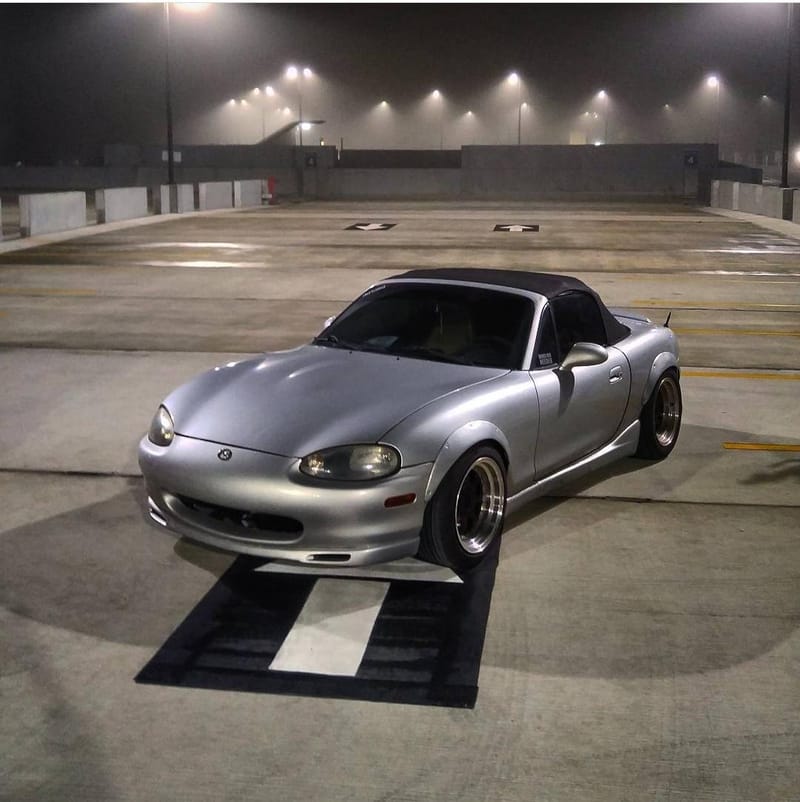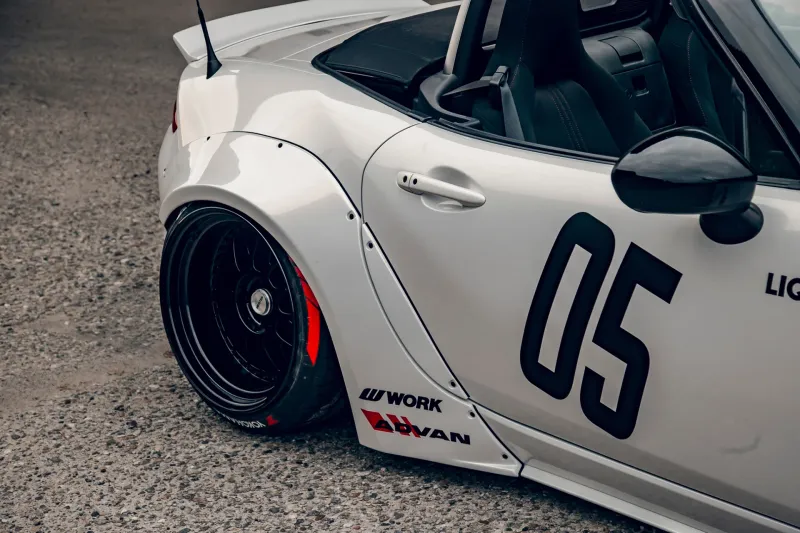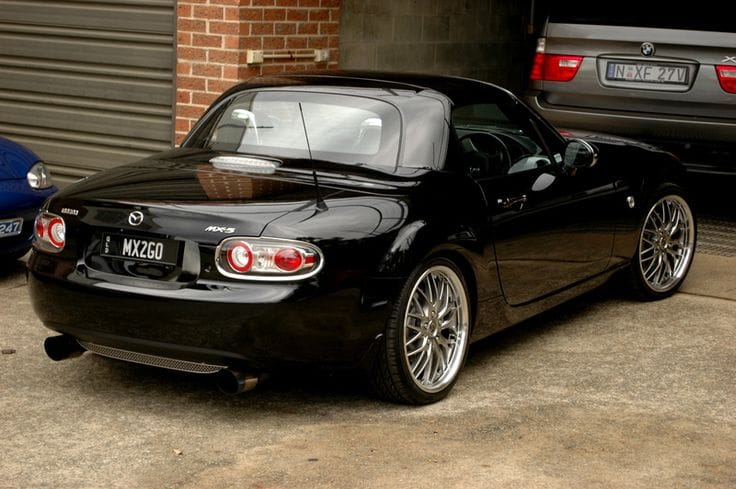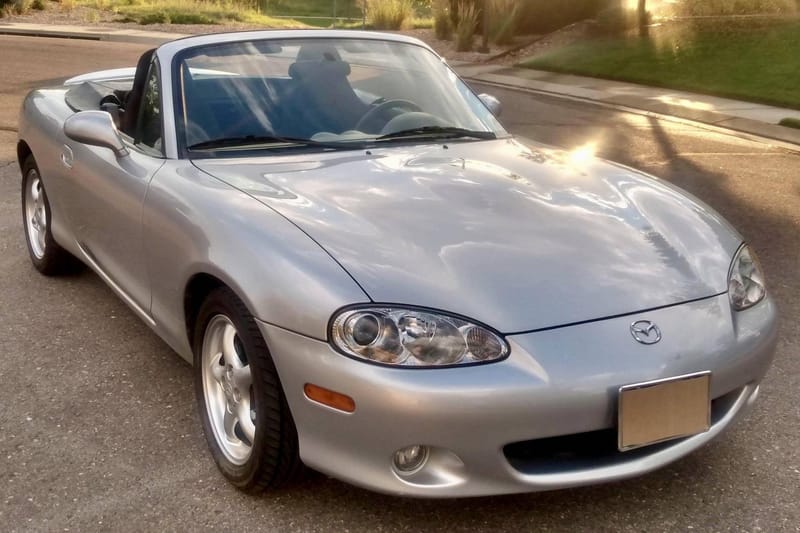A Deeper Dive in NA Miata Wheel Upgrades.
Ready to level up your Miata? Dive into advanced mods like forged vs. flow-formed wheels, specialized tires, big brake kits, five-lug conversions, and data-driven tuning. Whether you're aiming for track domination or a show-stopping stance, here’s how to take your build to the next level.
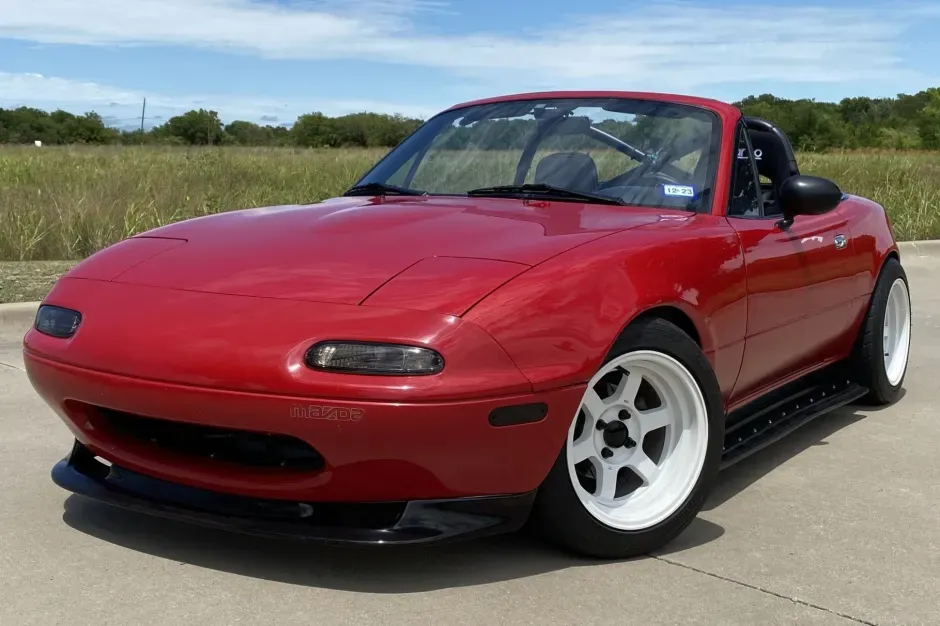
Today, we will go beyond the basics of tire upgrades. focusing on advanced modifications and fine-tuning techniques. We’ll look at forged versus flow-formed and multi-piece wheels, specialized tire compounds, big brake kits, five-lug conversions, and even how to collect real-world data to validate your upgrades. For Miata owners who started with simple flush setups and are ready for the next stage, be it chasing lap records or crafting an extreme stance build, this article has you covered.
Advanced Wheel Construction & Materials
Beyond the common cast wheels typically used by newcomers to the Miata scene, advanced construction methods can deliver remarkable benefits in strength, weight, and overall performance. Fully forged wheels are crafted from a solid billet of aluminum, creating a product with unparalleled strength-to-weight ratio, perfect for track enthusiasts who push their NA Miatas to the limit. Flow-formed wheels occupy a middle ground, offering greater durability than cast wheels but at a more budget-friendly price than fully forged. Meanwhile, multi-piece designs (two-piece or three-piece) are often reserved for high-end show builds or very specific, wide-fit applications. They allow for customization of lip size, offset, and finishes, though they can be heavier and demand regular checks for hardware tightness. Regardless of your choice, remember that lighter and stronger wheels reduce rotational mass, sharpen steering response, and improve braking efficiency, all key factors in unleashing the NA Miata’s full potential.

Wheel Sizing Nuances
Stepping into specialized widths and offsets can open doors for advanced handling setups or extreme fitments. A tried-and-true performance spec is the 15x9 with around +36 or +38 offset, often matched with 225/45R15 or 245/40R15 tires. This setup demands coilovers and negative camber but offers outstanding grip on track. On the other end of the spectrum, ultra-low offsets such as +10, 0, or even negative values are typically used on widebody or show builds, drastically altering the Miata’s stance but complicating daily drivability. If you’re upgrading brakes with larger rotors and beefier calipers, ensure your wheel backspacing accommodates these components. Lastly, while 15-inch wheels remain the sweet spot, some owners move up to 16- or 17-inch wheels to clear big brakes or achieve a certain aesthetic, keeping in mind the trade-off in sidewall height and ride comfort.
Tire Technology & Selection
Choosing the right tire is paramount to extracting the most from your wheel upgrade. High-performance street tires in the 200-treadwear category (like the Bridgestone Potenza RE-71RS or Yokohama Advan Neova AD09) offer a remarkable balance of grip, wear, and daily usability, though they may sacrifice some comfort and generate higher road noise. Dedicated track or R-compound tires push cornering limits even further, at the cost of faster wear and limited wet-weather capabilities. If you value longevity or drive year-round in varying climates, all-season or touring tires remain an option. Sidewall stiffness, tread pattern, and compound all heavily influence turn-in response, wet traction, and overall grip. For stance enthusiasts, tire stretching is common, fitting a narrower tire on a wider wheel for a dramatic look, but you trade off optimal contact patch and ultimate grip for aesthetics.

Suspension Geometry & Alignment for Advanced Fitment
Once you move beyond entry-level wheel and tire setups, it’s crucial to pay attention to suspension geometry. Corner balancing (sometimes called corner weighting) refines how weight is distributed across each wheel, an essential step for performance builds. Tweaking negative camber and toe settings further influences turn-in, stability, and tire wear. If you’ve significantly lowered your Miata, consider roll center and bump steer correction; extended ball joints or tie rod ends realign the suspension’s natural geometry so you don’t experience unpredictable steering over bumps. Together with adjustable control arms and upgraded bushings, these steps ensure that wider wheels and stickier tires don’t overpower your suspension’s design.
Fender Modifications & Body Enhancements
As wheel widths and offsets become more aggressive, you may need to modify the Miata’s sheet metal. Fender rolling flattens the inner lip, allowing for slightly wider tires and modest offsets. Fender pulling involves reshaping the outer fender itself, accommodating even bigger wheels or thicker tires. Going widebody opens up endless fitment possibilities, often pairing well with lip kits and aero additions like front splitters, side skirts, and rear diffusers. These changes not only provide space for extreme widths but can also enhance high-speed stability when done properly. Just be prepared for more extensive bodywork costs and potential paint blending to match your Miata’s factory color.

5-Lug Conversions & Brake Upgrades
For many NA Miata owners, the transition to a five-lug setup marks a significant leap in wheel and brake upgrade potential. A 5x114.3 pattern vastly increases available wheel choices, letting you tap into a wide array of designs and sizes typically found for popular Japanese sports cars. The conversion process might include replacing hubs, brake assemblies, and even upgrading suspension components to handle higher loads on track. If you’re focused on serious performance, big brake kits, Wilwood, StopTech, and Flyin’ Miata, among others, can vastly improve stopping power. Always double-check wheel clearance, as larger calipers may clash with certain spoke designs or barrel shapes, especially if your offsets lean toward more aggressive specs.
Real-World Testing & Data Collection
The best way to confirm your modifications is by gathering real-world data. Attending track days or autocross events lets you perform A/B testing with different wheel-and-tire setups, capturing lap times, cornering G-forces, and personal driving impressions. Data loggers like RaceChrono on a smartphone or dedicated devices like the AIM Solo can help quantify performance changes. You may also notice differences in brake temperatures, as open-spoke wheels often help dissipate heat more effectively. Outside the track environment, daily driving assessments reveal how well your chosen combination handles potholes, road noise, and overall ride comfort. Keep an eye on tire wear patterns, an uneven distribution of wear points to alignment issues that may need adjusting.
Style, Color, and Finishing Touches
Performance aside, your NA Miata’s look is a personal statement. Wheel finishes range from classic polished lips and diamond-cut faces to modern powder-coated or anodized designs. Retro styles from SSR or Watanabe suit the Miata’s 90s heritage, while more contemporary motorsport-inspired lines from Gram Lights or Enkei can give it a fresh edge. Adding personal touches like ceramic wheel coatings eases cleaning and offers mild scratch protection. Center caps, valve stems, and lug nuts also play a surprisingly large role in pulling together a cohesive look. Extended lug nuts, for instance, may add visual drama but could run afoul of certain track regulations, so always confirm what’s permissible at your local events.
Budgeting & Planning for the Future
When deciding on how best to invest, remember that good tires often deliver the most immediate and tangible boost to handling, followed by well-chosen wheels and suspension. If you’re on a tight budget but crave a track-focused setup, consider looking for deals on used high-end wheels, as the enthusiast community often recycles quality parts. Thinking ahead to potential engine swaps or an NB subframe upgrade is also wise; you might find it worthwhile to future-proof your hub and brake choices. Moreover, documenting your modifications can preserve resale value and make your NA Miata more appealing to fellow enthusiasts who understand the cost and effort behind name-brand parts and thoughtfully executed upgrades.
In pushing beyond the basics, you open up a whole new universe of performance and styling possibilities for your NA Miata. Advanced wheel materials, carefully selected tire compounds, proper suspension geometry, and thoughtful body modifications can collectively transform your Miata into a precision track tool or an attention-grabbing showpiece. It’s all about balancing cost, performance, and aesthetics to meet your specific goals. Share your experiences, swap tips, and compare data with fellow Miata owners at local meets or on popular forums, your feedback can spark the next round of insights. As you enjoy the fruits of your labor, keep in mind that there are always deeper rabbit holes to explore: forced induction setups, composite body panels for weight savings, and race-tuned suspension are just a few horizons to chase. Until then, savor the sharper handling, bolder appearance, and sheer driving joy that come from forging ahead with your wheel and tire upgrades.

